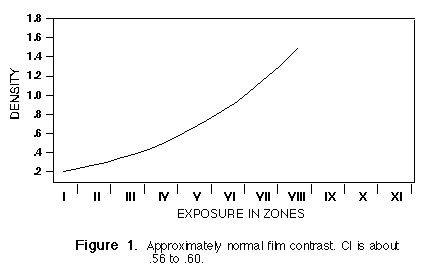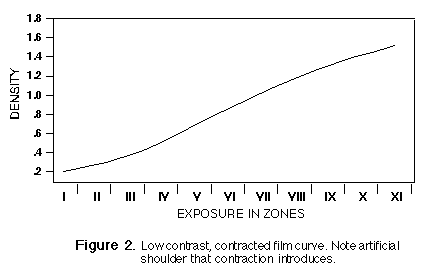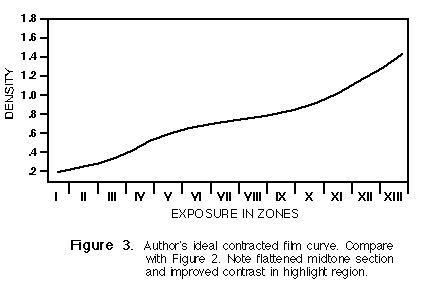
Zone System Contraction Part I
A New Theoretical Approach
©Copyright 1990 thru 2008 David Kachel
Article First Appeared in Darkroom & Creative Camera Techniques in May/June 1990
This is the first in a series of four articles on the subject of contraction (film contrast reduction). In “Selective Latent Image Manipulation Techniques,” “The Highlight Method” and “The Monobath Method,” respectively — I present three new techniques for Zone System contraction, resulting from some six years of research.
I devised these new techniques to replace what I regard as four largely ineffectual contrast-reduction methods. These methods include curtailed development time, water-bath development, two-bath development, and high dilution compensating development. I have largely abandoned these older techniques.
The purpose of this article is to provide a sound theoretical foundation for contraction in general, and to explain the need and rationale for the new contraction techniques described in the aforementioned articles. Prior to the first of appearance of this article in Darkroom a& Creative Camera Techniques in 1990,contraction has never been adequately discussed in print, and the subject has more than the usual quota of half-truths. For these reasons, this article will deal strictly with the theory of contraction.
Every Zone System text and article I have ever read, including those by Ansel Adams, has been in error with regard to defining the basic problem of contraction and how best to deal with that problem.
Most Zone System photographers consider the basic problem of contraction to be one of excessive contrast. In other words, it is believed contraction subjects have too much contrast. This is the obvious and logical conclusion. It is also incorrect!
To understand why this is so, we must start with the terminology of contraction.
Most Zone System photographers, myself included, have a nasty habit of saying “contrast” when we really want to say “reflectance range” or “density range.” We will mistakenly refer to a subject having greater than a 1:128 reflectance range (i.e. more than 8 or 9 stops of reflectance) as being high-contrast. Likewise we will also refer to a normally developed negative made from that same subject as having high-contrast, when in fact it only has an overly long density range. This laziness in usage gets us into conceptual trouble when we start talking about contraction. For example:
Imagine you are photographing a room illuminated by an open window. You make two different photographs. The first does not include the open window in the picture area, the second does. Otherwise the two photographs show approximately the same view of the room.
You measure the reflectances of the view that does not include the open window and find it to have a normal reflectance range. Then you take a reading from the open window and find that it adds several stops to the subject’s reflectance range for the second photograph.
Both negatives are exposed identically and are processed together at your normal development time. Discounting flare, you should be able to make identical prints of the room interior from these two negatives (cropping out the open window in the second print). They were after all, exposed and processed identically.
It is obvious from this example that both negatives have identical contrast! The only difference between the two is that the second negative has a longer density range because it includes the bright open window in the picture area.
Without the open window included in the photograph, the subject has a normal reflectance range. With it, the subject has a long reflectance range.
The foregoing should effectively illustrate that scenes do not have “contrast,” they only have different ranges of reflectance. (Scenes do have what is called “local contrast,” but that is another subject entirely.
I use the term contrast index (C.I.) when referring to film contrast. Eastman Kodak Company invented C.I. and the derivation procedure. C.I.’s get higher as film contrast increases. A C.I. number is roughly equal to Ilford’s average gradient (G), another contrast-measuring method (G = a predetermined film density range divided by the log exposure required to produce that density range). Gamma, a term I’m sure you’ve run across, also measures film contrast but is numerically different from C.I. and average gradient (G), and is now largely obsolete.
Contrast is the slope of the film’s characteristic curve and not the range of tones placed on it. A slope having a C.I. between about 0.56 and 0.60 is what most of us consider normal film contrast. See Figure 1. A steeper slope means a high-contrast negative, and a flatter curve means a low-contrast negative.

If a negative is processed to a C.I. of about 0.56 to 0.60, then it is a normal-contrast negative, regardless of the reflectance range of the subject to which it was exposed. The reflectance range of the subject cannot alter the negative contrast produced by development. Any negative processed for your “normal” development time must have normal contrast!
A contraction negative is developed to a lower C.I. than 0.56 to 0.60 (normal). It has a flattened curve and, by definition, has low contrast. See Figure 2. That this flattened curve may have received light from exposure Zones I through XII, or any other range of subject tones, is irrelevant. It has received reduced development and is therefore a low-contrast negative. Remember, contrast has nothing whatsoever to do with how many Zones of tone your subject contains. Contrast is strictly a function of how long and by what method you develop a negative—any negative. Contrast and subject tonal range are not related.

All contraction negatives receive less than normal development. Therefore all contraction negatives have flattened characteristic curves, or low contrast.
This leads us to the central misunderstanding of contraction. Contraction is not a problem of too much contrast; it is a problem of too little contrast. A negative that has been developed to a significantly lower-than-normal C.I. is of necessity, a low-contrast negative and is physically incapable of rendering a good print on grade 2 paper, despite the fact that it may have a density range matched perfectly to a grade 2 paper. Therefore, contraction is a problem of too little contrast.
With the occasional exception of some N-1 and rare N-2 negatives (due to some flexibility in what we regard as acceptable print contrast), all contraction negatives have inadequate contrast (not necessarily density range), or too flat a characteristic curve to be printed well on grade 2 paper. The decades-old Zone System concept of matching contraction negatives to grade 2 paper is invalid. The combination of a low-contrast negative and grade 2 paper must produce a low-contrast print, even though that print could well contain a full range of tones from black to white. Only a normal-contrast negative can produce a normal contrast print on normal paper. Contraction negatives are low contrast negatives, and we print low contrast negatives on high contrast paper. Printing them on normal (grade 2) paper must produce a low contrast print.
Photographers who regularly use contraction techniques know exactly what I’m talking about. Most contraction negatives are really printed on grade 3 or 4 paper, not grade 2. We invariably write this paradox off to error on our part, never considering that the error may lie with contraction theory itself.
Stated differently, contraction negatives printed on grade 2 paper show insufficient local contrast due to the tonal compaction (curve flattening) of contracted development. Photographically, the effect is a pronounced loss of tonal separation, especially in the highlights and shadows. Typically, we approach such problem negatives by trying to restore lost negative contrast when printing by employing higher contrast papers and dodging/burning-in. When printing such negatives, we’re trying to make the best possible compromises under the circumstances.
When we accepted conventional contraction theory, we freely adopted what I now regard as a severe misconception about the physics and chemistry of the photographic process. This misconception has to do with the idea of reducing contrast by depriving negative highlights of an adequate supply of developing agent. This approach is the basis for all previous contraction methods and is flawed. Film and paper are simply not designed to respond well to this type of development.
All traditional contraction methods are based on the same theory: if you provide an inadequate supply of developer to a negative, the shadows will develop completely and the highlights won’t, thereby reducing contrast and density range. This idea is flawed on several levels:
Certainly, the traditional contraction theory flaw most likely to be encountered on a daily basis is uneven development. Its cause is easy to illustrate. Simply expose a piece of print paper to a diffuse, even light source (your enlarger out of focus) to achieve about the equivalent of a Zone III black. Immerse the paper in developer under bright safelight illumination and agitate as usual. Use a non-developer-incorporated paper for this test. From the moment the image is first visible, count another five seconds, then pull the paper from the developer — stop and fix normally. When you examine this test print carefully, you’ll find that the print is badly mottled (unevenly developed). This same thing also occurs with film that has been developed for a short time. Here’s why this happens:
After immersing a negative in developer, some time must pass before the developer soaks into the emulsion. The liquid developer must first break the surface tension of the emulsion. Surface tension is not broken evenly, but rather in a splotchy, haphazard manner. Areas of identical tone, such as different parts of the sky, begin development at different times as the surface tension breaks in each area. This happens in all negatives, not just contracted ones.
With normal development, areas where surface tension was broken late and therefore development started late, have time to catch up because development has begun to slow as it nears completion in the areas that started first. (You can illustrate this using print paper and your standard development time.)
However, if you use a shortened development time, or any of the older contraction methods, the early-starting negative areas never approach complete development. (If they do, there is no contraction.) As a result, their development never slows, and areas of identical exposure but lagging development cannot catch up. The result: splotchy, unevenly developed negatives.
A plain water pre-soak is partially effective in dealing with this problem. However the pH differences between developer and emulsion-held water can cause similar surface tension difficulties.
There is another cause of uneven development brought on by older contraction methods. After surface tension has been broken and developer comes in contact with exposed grains, there is a delay before development begins. This delay is called the induction time. (Strictly speaking, induction time is measured from the moment film and developer meet.) It is different for each film-developer combination, and substantially faster with increasing exposure. I’m sure you’ve noticed this when developing an inadvertently overexposed print. Development can begin almost immediately when a print is grossly overexposed, and races to maximum black in seconds.
Film is no different. A Zone VIII exposure has a substantially shorter induction time than a Zone III exposure in the same negative. This is why a negative‘s highlights appear first during development, followed by the midtones and then the shadows.
Older contraction techniques work on the theory that there is sufficient developer present for adequate development of the shadows, but not the highlights. I’m sure you’ve read this many times. However, this theory does not take induction time and its developer dependency into consideration.
Most older contraction methods depend on low-concentration developers. The lower the developer concentration, the longer the induction time will be for all exposure areas. Induction requires a constant supply of fresh developer to occur. However don’t forget that by definition a contraction negative has areas that are overexposed, and as a result have shortened induction times. Therefore, while our older contraction method is slowing induction times at all levels, induction time is proportionately shortened in the highlights where heavy exposure has caused faster reaction to development.
The net result of this is that no matter the method (old) or developer concentration, the highlights of a contraction negative always race ahead, leaving shadows lagging behind. Giving additional exposure to support shadows invariably provides evener shorter induction times for highlights. This leads to a vicious cycle: The harder you try to get more contraction while maintaining shadow detail, the more you cause excessive unwanted highlight development.
From a practical standpoint these older contraction methods often do work well enough to get a printable negative, despite the grim picture I’ve painted here. However, a high-quality result is more often attributable to the photographer‘s printing prowess than to an optimum negative.
I think many photographers would be willing to use the older contraction methods, and put up with the limitations without complaining, if such processing didn’t have such a profoundly degrading effect on the way the subject is rendered. In addition to the problems of uneven development, speed loss and uncontrollable higher densities, these older contraction methods also reshape characteristic curves in ways we don’t intend.
Most older contraction methods rely on the concept of compensation: using a weak developer to complete development of higher exposure Zones in the time it takes them to complete development of lower exposure Zones. (High dilution, water bath and two-bath development all work on the principle of compensation.) Such developers give proportionally less attention (are increasingly less efficient) to progressively higher exposure levels (a smaller percentage of exposed grains in Zone XII will be developed than in Zone XI. etc). Such a compensating developer produces better effective film speed than curtailing time in a standard developer formulation. However, a compensating developer makes the greatest contrast sacrifice in the higher exposure Zones. The end result of this is the introduction of an artificial shoulder into the char
acteristic curve. Even reduced development time in a non-compensating developer, the simplest traditional approach, does this to a certain extent.
Figure 2 clearly shows a pronounced artificial shoulder for a normal-strength developer and reduced time. However, compensating developers make matters worse. Their severe curve flattening produces an even more drastic loss in contrast in the lighter print tones—those dull, lifeless highlights.
In addition, compensating development doesn’t just happen in the higher Zones. Zone III will also receive proportionately less development than Zone II, etc. For me, normal development typically produces Zones I to III in the vicinity of about 0.10, 0.25, and 0.40 densities respectively. However, even the most careful two-bath development is likely to produce densities near 0.10, 0.18, and 0.25, representing a severe loss of contrast and shadow separation. (This may vary considerably depending on the degree of contraction, film, etc.)
Although contrast in a contraction negative is also lost in the midtones, the worst losses happen in the shadows and highlights where we can least afford them. Darker tones show a greater contrast loss than midtones because the shadows fall on the film curve’s toe, which typically already has low contrast. Losses in the highlights are more severe than in the midtones because highlights are printed on the paper curve’s toe, which also has relatively low contrast. Interestingly, the comparatively small contrast loss in the midtones is further minimized because the straight line section of the paper’s characteristic curve replaces some of this lost contrast. This can be seen when film and paper curves are studied together (known as the “tone reproduction cycle”).
Many people shy away when someone brings up the tone reproduction cycle. It seems that many photographers feel comfortable dealing with film or paper curves individually, but grit their teeth when dealing with film and paper curves together. The interaction between film and paper curves causes a normal negative made from a normal subject range to print on a normal paper with increased midtone contrast. See Todd & Zakia’s book, Photographic Sensitometry (2nd Ed., Morgan & Morgan, 1981, pp. 90-94, “The Tone Reproduction Cycle”). Understanding this effect, it becomes obvious that to produce an excellent contraction negative, our best hope lies with minimizing the contrast loss in shadows and highlights and maximizing it in the midtones, the only part of the characteristic curve where there is contrast to spare. Rather than produce a contraction negative with a characteristic curve like that in Figure 2, we would much more ideally produce a curve like that in Figure 3. Such a curve makes the greatest contrast sacrifice in the midtones where we can most afford it. It was with this in mind that I began my experiments.

I believe we should be evaluating contraction negatives using some of the same criteria we use for normal negatives. Why should we have to make such large compromises as we have in the past?
It just makes sense to have contraction techniques that are free from the problems of uneven development, that reduce or eliminate film speed loss, and that are as malleable as possible, allowing maximum tonal control.
The new techniques I describe in “Selective Latent Image Manipulation Techniques,” “The Highlight Method” and “The Monobath Method.” address all of the contraction problems I’ve discussed in this article. While there is no perfect solution (hence three new techniques instead of only one), these techniques are vastly superior to older ones. Uneven development is virtually impossible with all three techniques. Film speed loss is zero regardless of the degree of contraction with the Monobath Method and the Highlight Method. To my own surprise, one technique has exploded into a whole new field of investigation of contrast and tone control for both B&W and color, and a variety of techniques. These techniques are collectively know as “Selective Latent Image Manipulation Techniques” or SLIMT’s.
David Kachel